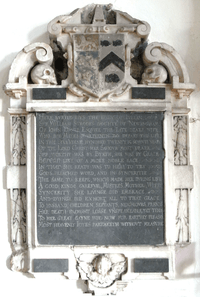Sir John Davie, 1st Baronet
Sir John Davie, 1st Baronet (1588–1654) of Creedy in the parish of Sandford, near Crediton, Devon, was a member of the Devonshire gentry and served as Member of Parliament for Tiverton in 1621-2 and as Sheriff of Devon (1629-1630). He was created a baronet in 1641.
Origins
Davie was the son and heir of John Davie of Sandford and Crediton, Devon by his wife Margaret Southcote, daughter of George Southcote, of Calverley, Devon.[2]
Career
He matriculated at Exeter College, Oxford on 22 February 1605, aged 16.[3] In 1621 he was elected Member of Parliament for the newly enfranchised constituency of Tiverton in Devon.[4] He served as Sheriff of Devon from 1629 to 1630. He was created a baronet on 9 September 1641.[2]
Marriages and progeny
Davie married twice:
- Firstly to his second cousin[5] Juliana Strode (d.1627), 5th daughter of Sir William Strode (1562-1637), MP, of Newnham, Plympton St Mary, Devon, by his 1st wife Mary Southcott (d.1617), daughter of Thomas Southcott (d.1600), of Indio, Bovey Tracey.[6] She was a sister of William Strode (1594-1645), MP,[7] one of the Five Members whose attempted arrest in the House of Commons by King Charles I in 1642 sparked the Civil War. She died on 14 May 1627 and was buried at Sandford on 25 May 1627. She is shown as one of his seven daughters sculpted in relief on the mural monument of Sir William Strode in Plympton St Mary Church. By Juliana he had progeny including:
- Sir John Davie, 2nd Baronet (1612-1678), eldest son and heir, MP for Tiverton.[2]
- William Davie (1614-1663) of Dar.(?),[8] 2nd son, barrister-at-law, who married Margaret Clarke (d.1702), daughter of Sir Francis Clarke (1622/3-c.1690), a merchant of the City of London and member of the Levant Company,[9] by whom he had progeny including:
- Sir John Davie, 3rd Baronet (1660–1692), eldest son, MP for Saltash 1679–85, Sheriff of Devon in 1688,[10] died unmarried.
- Sir William Davie, 4th Baronet (1662–1707), 2nd son and heir to his brother.
- Secondly he married Isabel Hele (d.1656) of Gnaton, Devon, by whom he had a daughter:
- Isabell Davie (1631-1673), who in 1649 married Sir Walter Yonge, 2nd Baronet (c. 1625-1670), MP, of Colyton, Devon.[11]
Monument to wife

A mural monument to his first wife Juliana Strode (d.1627) survives in Sandford Church, inscribed in verse as follows:
- Here buried lyes the body of Julian,
- Sur William Strode's daughter of Newingham,
- Of John Davie Esquire the late deare wife,
- Who did Maye's fourteenth day depart this life,
- In the sixteene hundred twenty & seventh yeare,
- Of the Lord Christ her saviour most deare.
- She worthy was by byrth, she was by grace,
- Berean-like[12] of a more noble race,
- In that she ready was to here, to try,
- God's preached word and in synceritie,
- The same to keepe which made her during life,
- A good, kinde, carefull mistres, mother, wife.
- Syncerity she livinge did embrace,
- And dyinge did exhort all to that grace.
- To husband, children, servants, neighbours, frends,
- Her death brought losse unspeakable yet tends,
- To her great gayne who now for earthly pleasure,
- Most heavenly joyes partaketh without measure".
Death and burial
Davie died in 1654 at the age of about 66 and was buried at Sandford on 13 October 1654.[3]
Sources
- Yerby, George & Hunneyball, Paul, biography of Davie, John (1589-1654), of Creedy House, Sandford, Devon, published in The History of Parliament: the House of Commons 1604-1629, ed. Andrew Thrush and John P. Ferris, 2010
References
- ↑ Also as blazoned in Vivian, Lt.Col. J.L., (Ed.) The Visitations of the County of Devon: Comprising the Heralds' Visitations of 1531, 1564 & 1620, Exeter, 1895, pedigree of Davie, p.269
- 1 2 3 "Complete baronetage". Archive.org. Retrieved 18 December 2014.
- 1 2 "Dabbe-Dirkin". British-history.ac.uk. Retrieved 18 December 2014.
- ↑ Notitia Parliamentaria, Or, An History of the Counties, Cities, and Boroughs ... Books.google.com. Retrieved 18 December 2014.
- ↑ Both were great-grand-children of John Southcott (d.1556) of Indio (See Vivian, p.719, pedigree of Strode)
- ↑ Vivian, p.699, pedigree of Southcott
- ↑ Vivian, Lt.Col. J.L., (Ed.) The Visitations of the County of Devon: Comprising the Heralds' Visitations of 1531, 1564 & 1620, Exeter, 1895, p.719, pedigree of Strode
- ↑ Vivian, p.270, printed with last letter missing
- ↑ Sir Francis Clarke (1622/3-c.1690), knighted 1665, "His second wife (whom he married in 1667) was a thirty year old spinster, Elizabeth Proby, of Mortlake, Surrey. Clarke's City of London house was on the south side of Fenchurch Street in the parish of St Gabriel. It was a relatively modest ten hearth residence. He also had a house in Putney, Surrey. Sir Francis Clarke was from Devon and Dorset born parents. His father was Christopher Clarke, a justice of the peace in Exeter, and his mother, Francis Pitt, was from Weymouth, Dorset. He died intestate in 1690, at the age of about sixty-eight, and was buried at St. Helen's, Bishopsgate."
- ↑ Prince, John, (1643–1723) The Worthies of Devon, 1810 edition, London, p.282
- ↑ Vivian, p.840, pedigree of Yonge
- ↑ Berean: according to the Book of Acts, Chapter 17 verses 11-12, Paul of Tarsus and Silas preached at Berea, of which the inhabitants "Were more noble than those in Thessalonica in that they received the word with all readiness of mind, and searched the scriptures daily, whether those things were so. Therefore many of them believed". (King James Bible)
| Parliament of England | ||
|---|---|---|
| Preceded by Newly enfranchised |
Member of Parliament for Tiverton 1621=1622 With: John Bampfield |
Succeeded by Sir George Chudleigh Humphrey Weare |
| Baronetage of England | ||
| New creation | Baronet (of Creedy) 1641–1654 |
Succeeded by Sir John Davie |